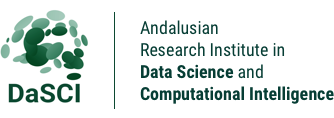Key biomarkers discovered for early detection of Alzheimer’s in people with Down’s syndrome
4 April, 2025
UGR scientists participate in an international study that has identified 15 proteins in blood that may function as early indicators of the development of the disease
Down syndrome is associated with an increased risk of suffering Alzheimer’s due to the triplication of the APP gene on chromosome 21.
Researchers from the University of Granada’s DaSCI and CITIC centres, in collaboration with an international team, have identified biomarkers in blood that could revolutionise the early diagnosis of Alzheimer’s disease in people with Down’s syndrome.
The study, published in the journal Alzheimer’s & Dementia, has analysed more than 3,000 plasma proteins to find fundamental differences between people with Down’s syndrome with and without Alzheimer’s symptoms.
People with Down’s syndrome have an increased risk of developing Alzheimer’s due to the triplication of the APP gene on chromosome 21. This genetic alteration leads to the accumulation of toxic proteins in the brain from an early age. However, clinical detection of dementia remains a challenge, due to the variability in the presentation of Down syndrome symptoms, which requires highly qualified personnel to discern which symptoms belong to Down syndrome and which belong to dementia.
Dr Carmen Jiménez, researcher at the University of Granada and co-author of the study, explains: “Down syndrome offers us a unique window to understand Alzheimer’s from a genetic perspective. This study brings us closer to more precise tools for early diagnosis and possible therapeutic strategies”.UGR scientists participate in an international study that has identified 15 proteins in blood that may function as early indicators of the development of the disease
Down syndrome is associated with an increased risk of Alzheimer’s due to the triplication of the APP gene on chromosome 21.

Using state-of-the-art proteomic analysis technology, the team of scientists has found 15 proteins in blood that may function as early indicators of disease development. Among the most promising biomarkers are neurofilament light protein (NFL) and glial fibrillary acidic acidic protein (GFAP), both of which are related to neurodegeneration.
UGR researcher Rocío Romero Zaliz adds: “Proteomic analysis using bioinformatics tools has allowed us to discover patterns that were previously invisible. We hope that these findings can be translated into tangible clinical advances in the short term.
This discovery may pave the way for the implementation of more accessible and less invasive screening tests, allowing for earlier diagnosis and the possibility of more effective medical interventions. ‘The identification of these biomarkers is a fundamental step towards establishing an objective and early diagnosis of dementia in Down’s syndrome, where other factors related to the disease delay access to appropriate treatments before it progresses,’ says Francisco Jesús Martínez Murcia, one of the study’s authors.
The work has been carried out in collaboration with institutions such as the Ludwig-Maximilians-University of Munich and the Helmholtz Zentrum München in Germany, and at a national level, the Memory Unit of the Hospital de la Santa Creu i Sant Pau in Barcelona, a reference centre for dementia and Down’s syndrome.
Funded by several European and US institutions, this research highlights the importance of international cooperation in biomedical research. The scientists stress the need for further progress in longitudinal studies to confirm these findings and evaluate their application in clinical practice. In the meantime, this breakthrough represents hope for improving the detection and treatment of Alzheimer’s disease in a particularly vulnerable population.
DaSCI
The Andalusian Inter-University Institute in Data Science and Computational Intelligence, known as DaSCI, is a collaborative entity between the universities of Granada, Jaén and Córdoba. It is dedicated to advanced research and training in the field of artificial intelligence, with a particular focus on data science and computational intelligence.
The institute brings together an outstanding group of researchers working on joint projects, promoting the development and application of innovative technologies in various sectors. With the aim of becoming a benchmark in its field, the DaSCI promotes the transfer of scientific knowledge to the socio-economic environment, thus contributing to technological progress and the digitisation of industry.
Contact:
Francisco Jesús Martínez Murcia. Departamento de Teoría de la Señal, Telemática y Comunicaciones
Instituto DaSCI. Universidad de Granada. Correo electrónico: fjesusmartinez@ugr.es
Juan M. Górriz. Departamento de Teoría de la Señal, Telemática y Comunicaciones
Instituto DaSCI. Universidad de Granada. Correo electrónico: gorriz@ugr.es
Bibliographic reference:
Wagemann O, Nübling G,Martínez-Murcia FJ, et al. Exploratory analysis of theproteomic profile in plasma in adults with Down syndrome inthe context of Alzheimer’s disease. Alzheimer’s Dement. 2025;21:e70040. https://doi.org/10.1002/alz.70040





